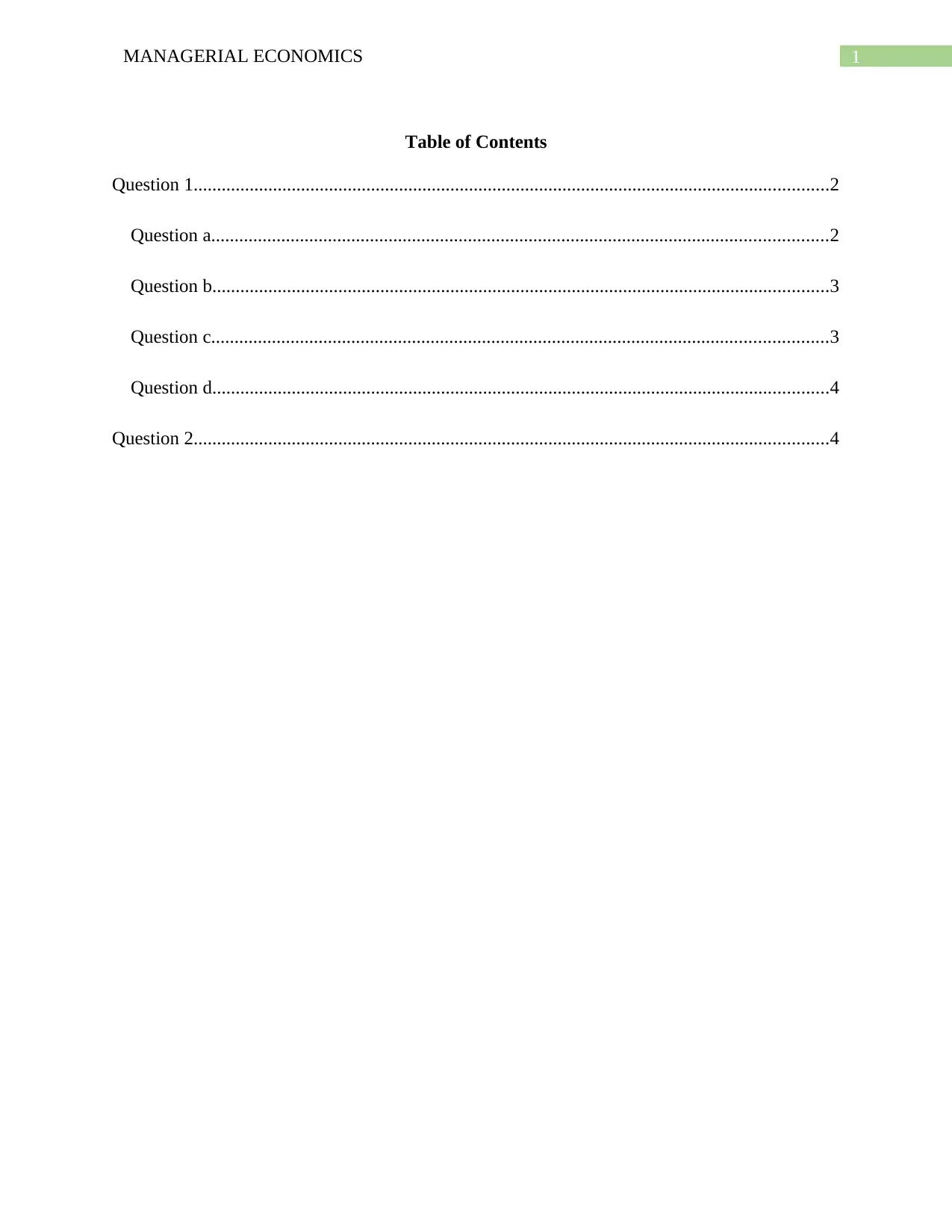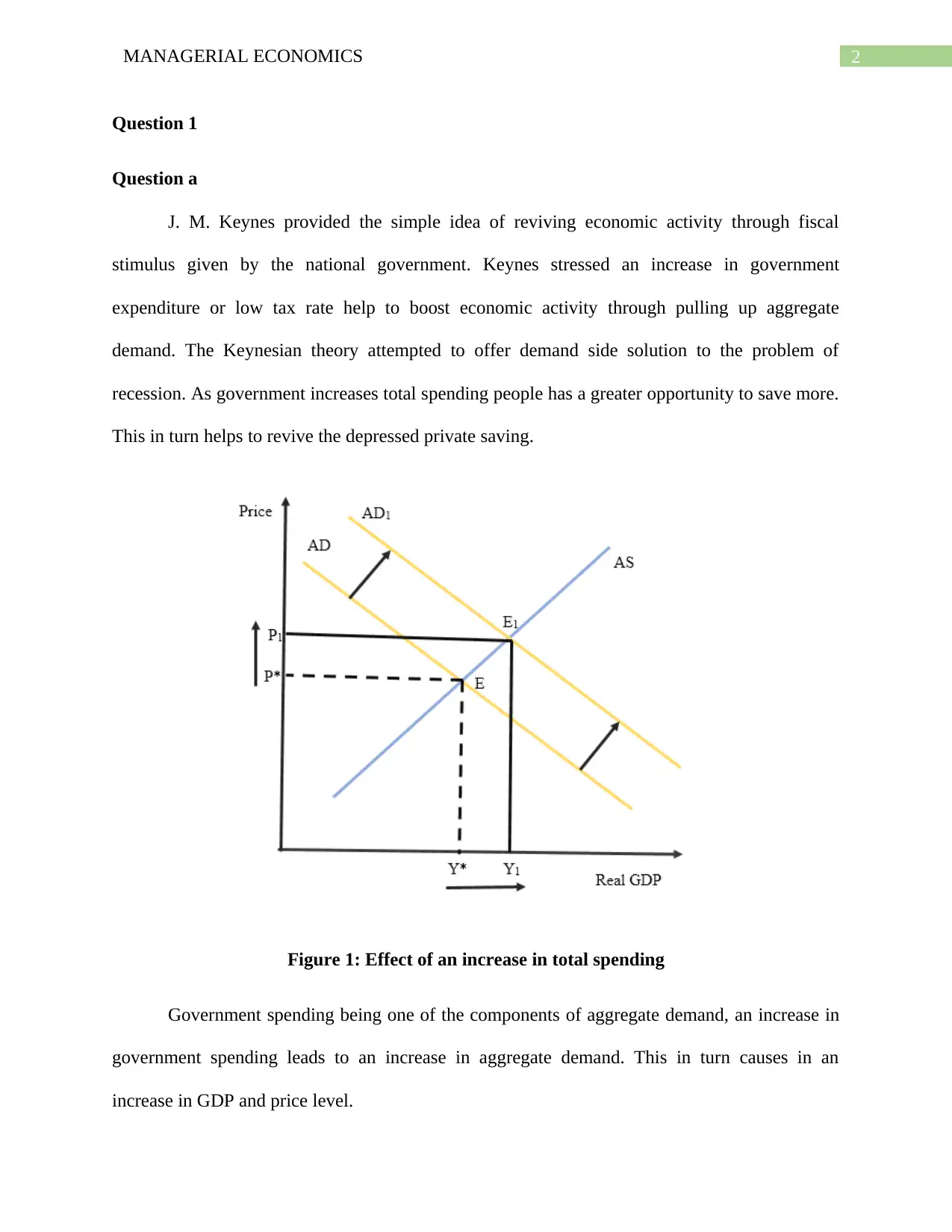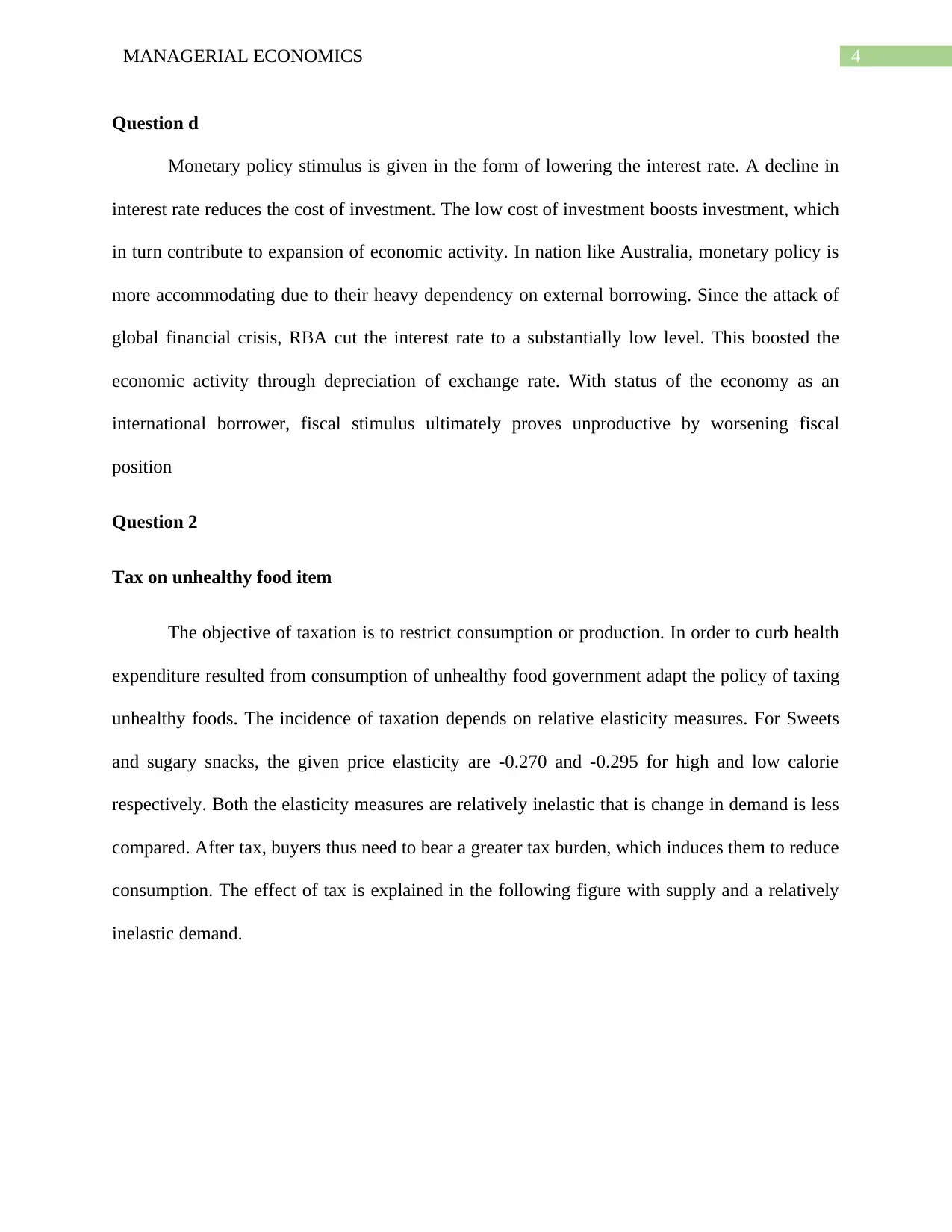BUS702: Managerial Economics Assignment - Fiscal & Monetary Policy
VerifiedAdded on 2023/06/04
|7
|851
|307
Homework Assignment
AI Summary
This managerial economics assignment delves into the application of fiscal and monetary policies, exploring their impact on economic activity. The assignment begins by examining Keynesian economics and the role of government spending in stimulating the economy. It differentiates between automatic stabilizers and discretionary fiscal policy, analyzing the effects of fiscal contraction and monetary policy stimulus. Furthermore, the assignment investigates the use of taxation on unhealthy food items and subsidies on healthy food products, evaluating their impact on consumption patterns using elasticity measures and graphical representations. The analysis provides a comprehensive understanding of how these economic tools are utilized to influence market dynamics and achieve specific policy objectives, such as controlling health expenditure and promoting healthier choices.

Running head: MANAGERIAL ECONOMICS
Managerial Economics
Name of the Student
Name of the University
Course ID
Managerial Economics
Name of the Student
Name of the University
Course ID
Paraphrase This Document
Need a fresh take? Get an instant paraphrase of this document with our AI Paraphraser

1MANAGERIAL ECONOMICS
Table of Contents
Question 1........................................................................................................................................2
Question a....................................................................................................................................2
Question b....................................................................................................................................3
Question c....................................................................................................................................3
Question d....................................................................................................................................4
Question 2........................................................................................................................................4
Table of Contents
Question 1........................................................................................................................................2
Question a....................................................................................................................................2
Question b....................................................................................................................................3
Question c....................................................................................................................................3
Question d....................................................................................................................................4
Question 2........................................................................................................................................4

2MANAGERIAL ECONOMICS
Question 1
Question a
J. M. Keynes provided the simple idea of reviving economic activity through fiscal
stimulus given by the national government. Keynes stressed an increase in government
expenditure or low tax rate help to boost economic activity through pulling up aggregate
demand. The Keynesian theory attempted to offer demand side solution to the problem of
recession. As government increases total spending people has a greater opportunity to save more.
This in turn helps to revive the depressed private saving.
Figure 1: Effect of an increase in total spending
Government spending being one of the components of aggregate demand, an increase in
government spending leads to an increase in aggregate demand. This in turn causes in an
increase in GDP and price level.
Question 1
Question a
J. M. Keynes provided the simple idea of reviving economic activity through fiscal
stimulus given by the national government. Keynes stressed an increase in government
expenditure or low tax rate help to boost economic activity through pulling up aggregate
demand. The Keynesian theory attempted to offer demand side solution to the problem of
recession. As government increases total spending people has a greater opportunity to save more.
This in turn helps to revive the depressed private saving.
Figure 1: Effect of an increase in total spending
Government spending being one of the components of aggregate demand, an increase in
government spending leads to an increase in aggregate demand. This in turn causes in an
increase in GDP and price level.
⊘ This is a preview!⊘
Do you want full access?
Subscribe today to unlock all pages.

Trusted by 1+ million students worldwide

3MANAGERIAL ECONOMICS
Question b
Fiscal policy is an instrument used to stabilize the economy. There are two main
instruments of fiscal policy – automatic stabilizer and discretionary policy. Automatic stabilizers
are in built mechanism that are designed to automatically adjust government expenditures or
taxation to influence aggregate demand. For example, during recession government expenditure
on unemployment benefit automatically increases. On the other hand, because of lower income
during this time, government tax revenue reduces. As spending exceeds government revenue,
there is a deficit in fiscal budget during recession.
Discretionary fiscal policy refers to the non-compulsory changes in government
spending, tax and other fiscal activity with respect to change in state of the economy. Examples
of discretionary fiscal policy include expenditure on roads, stadiums, bridges and other public
expenditure and cut in taxes. Expansionary policy results in surplus in budget while tight fiscal
policy leads to a deficit in budget.
Question c
The fiscal contraction is undertaken in the form of a decline in government expenditure
or increase in tax rate. Decline in government spending in wasteful program may have a positive
impact on the economy and help to improve macroeconomic performance. Cutting down of
unnecessary expenditure strengthens fiscal position. This in turn has a crowd in impact on
private on private investment. The increase in private investment helps to increase national
income. A contraction in the government expenditure therefore works through the channel of a
decline in interest rate, which stimulate investment and national income. This contradicts
Keynesian view of fiscal policy as an effective counter cyclical policy instrument.
Question b
Fiscal policy is an instrument used to stabilize the economy. There are two main
instruments of fiscal policy – automatic stabilizer and discretionary policy. Automatic stabilizers
are in built mechanism that are designed to automatically adjust government expenditures or
taxation to influence aggregate demand. For example, during recession government expenditure
on unemployment benefit automatically increases. On the other hand, because of lower income
during this time, government tax revenue reduces. As spending exceeds government revenue,
there is a deficit in fiscal budget during recession.
Discretionary fiscal policy refers to the non-compulsory changes in government
spending, tax and other fiscal activity with respect to change in state of the economy. Examples
of discretionary fiscal policy include expenditure on roads, stadiums, bridges and other public
expenditure and cut in taxes. Expansionary policy results in surplus in budget while tight fiscal
policy leads to a deficit in budget.
Question c
The fiscal contraction is undertaken in the form of a decline in government expenditure
or increase in tax rate. Decline in government spending in wasteful program may have a positive
impact on the economy and help to improve macroeconomic performance. Cutting down of
unnecessary expenditure strengthens fiscal position. This in turn has a crowd in impact on
private on private investment. The increase in private investment helps to increase national
income. A contraction in the government expenditure therefore works through the channel of a
decline in interest rate, which stimulate investment and national income. This contradicts
Keynesian view of fiscal policy as an effective counter cyclical policy instrument.
Paraphrase This Document
Need a fresh take? Get an instant paraphrase of this document with our AI Paraphraser

4MANAGERIAL ECONOMICS
Question d
Monetary policy stimulus is given in the form of lowering the interest rate. A decline in
interest rate reduces the cost of investment. The low cost of investment boosts investment, which
in turn contribute to expansion of economic activity. In nation like Australia, monetary policy is
more accommodating due to their heavy dependency on external borrowing. Since the attack of
global financial crisis, RBA cut the interest rate to a substantially low level. This boosted the
economic activity through depreciation of exchange rate. With status of the economy as an
international borrower, fiscal stimulus ultimately proves unproductive by worsening fiscal
position
Question 2
Tax on unhealthy food item
The objective of taxation is to restrict consumption or production. In order to curb health
expenditure resulted from consumption of unhealthy food government adapt the policy of taxing
unhealthy foods. The incidence of taxation depends on relative elasticity measures. For Sweets
and sugary snacks, the given price elasticity are -0.270 and -0.295 for high and low calorie
respectively. Both the elasticity measures are relatively inelastic that is change in demand is less
compared. After tax, buyers thus need to bear a greater tax burden, which induces them to reduce
consumption. The effect of tax is explained in the following figure with supply and a relatively
inelastic demand.
Question d
Monetary policy stimulus is given in the form of lowering the interest rate. A decline in
interest rate reduces the cost of investment. The low cost of investment boosts investment, which
in turn contribute to expansion of economic activity. In nation like Australia, monetary policy is
more accommodating due to their heavy dependency on external borrowing. Since the attack of
global financial crisis, RBA cut the interest rate to a substantially low level. This boosted the
economic activity through depreciation of exchange rate. With status of the economy as an
international borrower, fiscal stimulus ultimately proves unproductive by worsening fiscal
position
Question 2
Tax on unhealthy food item
The objective of taxation is to restrict consumption or production. In order to curb health
expenditure resulted from consumption of unhealthy food government adapt the policy of taxing
unhealthy foods. The incidence of taxation depends on relative elasticity measures. For Sweets
and sugary snacks, the given price elasticity are -0.270 and -0.295 for high and low calorie
respectively. Both the elasticity measures are relatively inelastic that is change in demand is less
compared. After tax, buyers thus need to bear a greater tax burden, which induces them to reduce
consumption. The effect of tax is explained in the following figure with supply and a relatively
inelastic demand.

5MANAGERIAL ECONOMICS
Figure 2: Impact of tax on unhealthy food
Subsidy on healthy food products
Subsidy on the other hand is given to encourage consumption and production of specific
items. The given elasticity measures show that fruits and vegetables have a relatively elastic
demand. Demand thus changes more in response to change in prices. The effectiveness of a
subsidy measure is illustrated in the following figure
Figure 2: Impact of tax on unhealthy food
Subsidy on healthy food products
Subsidy on the other hand is given to encourage consumption and production of specific
items. The given elasticity measures show that fruits and vegetables have a relatively elastic
demand. Demand thus changes more in response to change in prices. The effectiveness of a
subsidy measure is illustrated in the following figure
⊘ This is a preview!⊘
Do you want full access?
Subscribe today to unlock all pages.

Trusted by 1+ million students worldwide

6MANAGERIAL ECONOMICS
Figure 3: Impact of subsidy on healthy food
The flatter downward sloping curve shows the demand curve for healthy food. The
upward sloping curve indicates supply in the market. With subsidy, supply in the market
increases to S2S2. After subsidy is given, sellers receive a higher price while buyers pay a lower
price. The equilibrium quantity in the market raises to Q2.
Figure 3: Impact of subsidy on healthy food
The flatter downward sloping curve shows the demand curve for healthy food. The
upward sloping curve indicates supply in the market. With subsidy, supply in the market
increases to S2S2. After subsidy is given, sellers receive a higher price while buyers pay a lower
price. The equilibrium quantity in the market raises to Q2.
1 out of 7
Related Documents
Your All-in-One AI-Powered Toolkit for Academic Success.
+13062052269
info@desklib.com
Available 24*7 on WhatsApp / Email
![[object Object]](/_next/static/media/star-bottom.7253800d.svg)
Unlock your academic potential
Copyright © 2020–2026 A2Z Services. All Rights Reserved. Developed and managed by ZUCOL.





